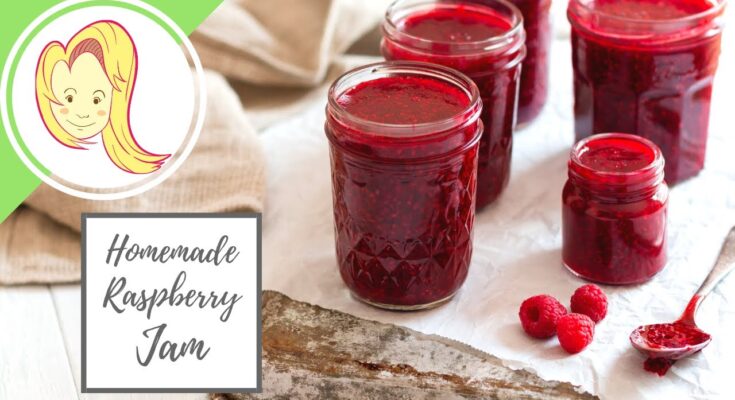Raspberry Jam Recipe: If there’s one thing that can take a simple toast or dessert to the next level, it’s raspberry jam. Tangy, sweet, and bursting with real fruit flavor, raspberry jam is a favorite in households around the world. Whether you’re a jam-making novice or someone who loves to get creative in the kitchen, this step-by-step guide will walk you through everything you need to know to make the perfect batch of raspberry jam from scratch. Spoiler alert: it’s way easier than you think!
What is Raspberry Jam?
Raspberry jam is a type of fruit preserve made by cooking raspberries with sugar until it reaches a thick, spreadable consistency. Unlike jelly, which is made from fruit juice, jam uses the whole fruit—seeds and all—which gives it a more intense flavor and satisfying texture. What makes raspberry jam stand out is its unique balance of tartness and sweetness, making it a versatile addition to both sweet and savory dishes.
Why Homemade is Better?
Let’s be real—store-bought jams can be convenient, but they often come with a long list of ingredients you can’t pronounce. When you make your own raspberry jam, you know exactly what’s going into it: real fruit, sugar, and maybe a splash of lemon juice. No preservatives, no artificial flavors, just the good stuff. Plus, the flavor of homemade raspberry jam? Unmatched. It’s brighter, fresher, and more vibrant than anything you’ll find on a grocery store shelf. And let’s not forget the pride that comes from making it yourself—it’s a labor of love that tastes like victory.
Ingredients Needed for Raspberry Jam
Choosing the Right Raspberries
The heart of this recipe is, of course, the raspberries. And choosing the right kind makes all the difference. Fresh raspberries are ideal—they’re fragrant, juicy, and give the jam that classic tart-sweet flavor. If you’re buying from the store or farmers market, look for berries that are plump, firm, and deeply red. Avoid any that are mushy or moldy. Can’t find fresh? No worries. Frozen raspberries work too—just make sure they’re unsweetened and thaw them before cooking.
Pro tip: If you like your jam seedless, you can press the raspberries through a fine mesh strainer before cooking. But let’s be honest—those tiny seeds give jam its rustic charm.
Other Essential Ingredients
Making raspberry jam is delightfully simple because you only need a few ingredients. Here’s what you’ll need:
- 4 cups of raspberries (fresh or thawed frozen)
- 2 cups of granulated sugar
- 2 tablespoons of lemon juice (freshly squeezed is best)
That’s it. No pectin, no fancy additives. Raspberries are naturally high in pectin, especially when they’re slightly underripe, so you can skip the store-bought stuff altogether.
Equipment You’ll Need
Basic Kitchen Tools
You don’t need a high-end kitchen to whip up some jam. Just gather these essentials:
- A large saucepan or jam pot (non-reactive like stainless steel or enamel)
- A wooden spoon or heat-resistant spatula
- A ladle for transferring the jam
- Measuring cups and spoons
- Clean jars with lids (preferably mason jars)
These tools are probably already in your kitchen, which means you’re halfway there!
Optional but Helpful Tools
While not mandatory, a few extra tools can make the process smoother:
- A candy thermometer to check the jam’s temperature (220°F is your goal)
- A jar funnel for mess-free filling
- A jar lifter if you plan to water-bath can your jam
- A mesh strainer if you want to remove seeds
Step-by-Step Guide to Making Raspberry Jam
Step 1: Wash and Prep the Raspberries
Start by rinsing your raspberries under cool water. Gently shake off excess water and pick out any stems or bad berries. If you’re using frozen berries, just let them thaw completely in a bowl before you begin. Once ready, you can mash them slightly with a fork or potato masher to get the juices flowing—this helps the sugar dissolve more easily during cooking.
Step 2: Cook the Raspberries
Place your berries in a large saucepan over medium heat. As they heat up, they’ll start to break down and release their juices. Stir frequently to prevent scorching, and after about 5–10 minutes, your mixture will be a bubbling, juicy base ready for sugar.
Step 3: Add Sugar and Lemon Juice
Now’s the time to stir in your sugar and lemon juice. The sugar helps preserve the jam and gives it that sweet kick, while the lemon juice adds brightness and helps the jam set. Stir constantly until the sugar has dissolved completely. Then turn up the heat and bring the mixture to a rolling boil.
Step 4: Check the Jam Consistency
This is where the magic happens. Keep boiling and stirring until the jam thickens. If you’re using a thermometer, aim for 220°F. If you don’t have one, try the spoon test: dip a cold spoon into the jam and let it cool—if it wrinkles when you push it with your finger, it’s done!
Step 5: Sterilize and Fill Jars
While your jam is cooking, sterilize your jars by boiling them in water for 10 minutes. Carefully ladle the hot jam into the jars, leaving about 1/4-inch space at the top. Wipe the rims clean, seal with the lids, and let them cool. For longer storage, you can water-bath can them for 10 more minutes.
Tips for Perfect Raspberry Jam
Avoiding Overcooking
Making raspberry jam is a bit like dancing—you need the right rhythm. Cook it too little, and you’re left with a runny mess. Cook it too long, and you risk a stiff, caramelized jam that lacks that juicy, fresh raspberry flavor. One of the best tips is to stay close to your jam while it’s boiling. Don’t wander off! Stir often to prevent burning at the bottom, and start checking for doneness after about 8–10 minutes of boiling.
A great trick is the “cold plate test.” Pop a plate in the freezer before you start cooking. When you’re ready to test your jam, drop a bit on the cold plate, wait 30 seconds, and run your finger through it. If it wrinkles slightly and stays separated, you’ve nailed it. If not, give it a few more minutes and try again.
Balancing Sweetness and Tartness
One of the beautiful things about raspberry jam is its balance of tart and sweet. But not all raspberries are created equal—some might be sweeter or more sour than others. If your berries are on the tart side, you can add an extra tablespoon of sugar, but don’t go overboard. The key is to highlight the natural raspberry flavor, not drown it.
Lemon juice isn’t just there to balance flavor; it also helps activate the natural pectin in the fruit, which helps the jam set. If your jam tastes flat, try adding just a touch more lemon juice before bottling.
Storing and Preserving Raspberry Jam
Best Storage Practices
Once your jars are sealed and cooled, you have two main storage options. If you’ve water-bath canned your jam properly, the sealed jars can be stored in a cool, dark place like a pantry for up to a year. Always label them with the date you made them so you don’t lose track.
If you skipped the water bath, no worries! Just store your sealed jars in the fridge. They’ll stay fresh for up to 3 months. Once opened, use within 3–4 weeks for the best taste and quality.
Shelf Life and Signs of Spoilage
Homemade jam doesn’t contain preservatives, so it’s important to know the signs of spoilage. If your jam develops mold, off smells, or any bubbling after opening, it’s time to toss it. When stored correctly, though, most jams are pretty stable and can last a long time.
Always use a clean spoon when scooping jam from the jar to avoid introducing bacteria. Trust your senses—if it smells funky or looks weird, don’t take the risk.
Creative Ways to Use Raspberry Jam
Sweet Treats and Breakfast Ideas
You might think jam is just for toast, but it’s way more versatile. Here are some sweet ideas:
- Swirl it into yogurt or oatmeal for a fruity upgrade.
- Use it as a filling for thumbprint cookies or sandwich cookies.
- Layer it into cakes, cupcakes, or trifles.
- Spread it on pancakes, waffles, or crepes.
- Add a spoonful to your favorite smoothie for extra zing.
Basically, anywhere you’d use fruit, raspberry jam can step in and elevate the dish with a punch of sweet-tart goodness.
Savory Dishes and Glazes
Raspberry jam isn’t just for sweet tooths. Try these savory applications:
- Mix it with balsamic vinegar and olive oil for a fruity salad dressing.
- Glaze meats like chicken, pork, or duck for a gourmet finish.
- Pair it with soft cheeses like brie or goat cheese for a killer appetizer.
- Stir it into BBQ sauces for a raspberry twist.
- Use it in a marinade to tenderize and flavor meats.
The possibilities are endless, and you’ll be surprised how well it pairs with rich, savory foods.
FAQs about Raspberry Jam Recipe
1. What ingredients do I need for a basic raspberry jam recipe?
To make raspberry jam, you typically need fresh raspberries, sugar, and lemon juice. Pectin is optional but can be added if you prefer a thicker consistency.
2. How long does it take to make homemade raspberry jam?
Making raspberry jam can take about 30 minutes to cook, plus preparation and canning time if you choose to preserve your jam for longer storage.
3. Can I make raspberry jam without pectin?
Yes, you can make raspberry jam without pectin. The natural pectin in raspberries and the addition of lemon juice will help the jam to thicken as it cooks.
4. What is the best way to store raspberry jam?
Raspberry jam can be stored in airtight containers in the refrigerator for up to three weeks. For longer storage, you can seal it in sterilized jars and process it in a water bath canner, allowing it to keep for up to a year.
5. Can I use frozen raspberries to make jam?
Absolutely! Frozen raspberries work well for jam-making. Just ensure they are fully thawed and drained to remove excess water before you start.
6. How do I know when my raspberry jam is ready?
You can test if your jam is ready by placing a small amount on a cold plate. If it gels and wrinkles when pushed with a finger, it’s set.
7. Is it necessary to sterilize jars before canning raspberry jam?
Yes, sterilizing jars before canning is crucial to prevent microbial growth and ensure the safety and longevity of your jam.
8. What are some creative ways to use raspberry jam?
Raspberry jam isn’t just for toast! Use it as a filling for cakes and doughnuts, swirl it into yogurt, or pair it with cheese and crackers for a delightful snack.
Conclusion
Homemade raspberry jam is more than just a spread—it’s a celebration of fruit, flavor, and old-school kitchen love. With just a handful of ingredients and some simple steps, you can create a delicious, versatile jam that’s better than anything you’ll find in a store. Whether you smear it on toast, use it in desserts, or get creative with savory dishes, your homemade jam will add a burst of sunshine to every bite.
And the best part? You made it yourself. So grab a spoon (or a whole slice of bread) and enjoy the sweet reward of your effort.



